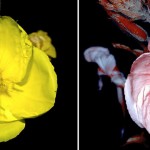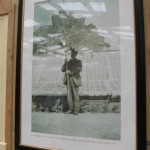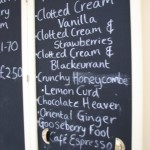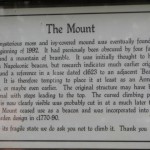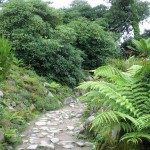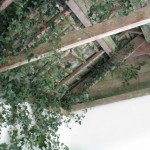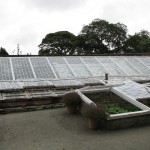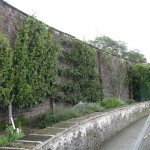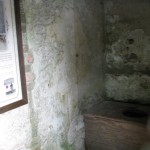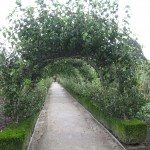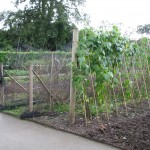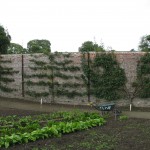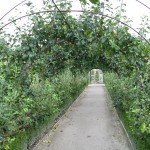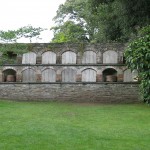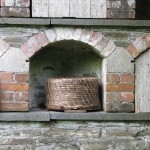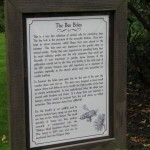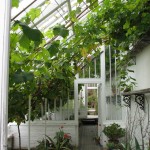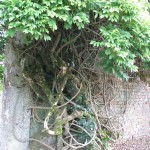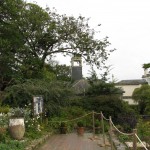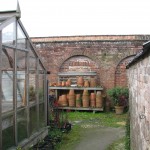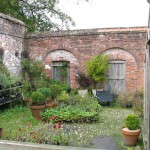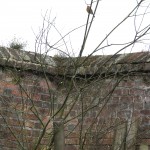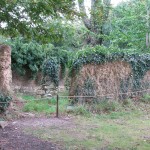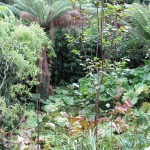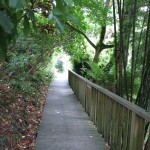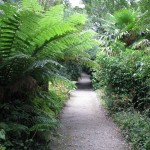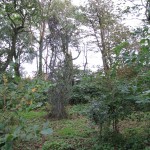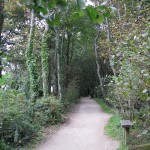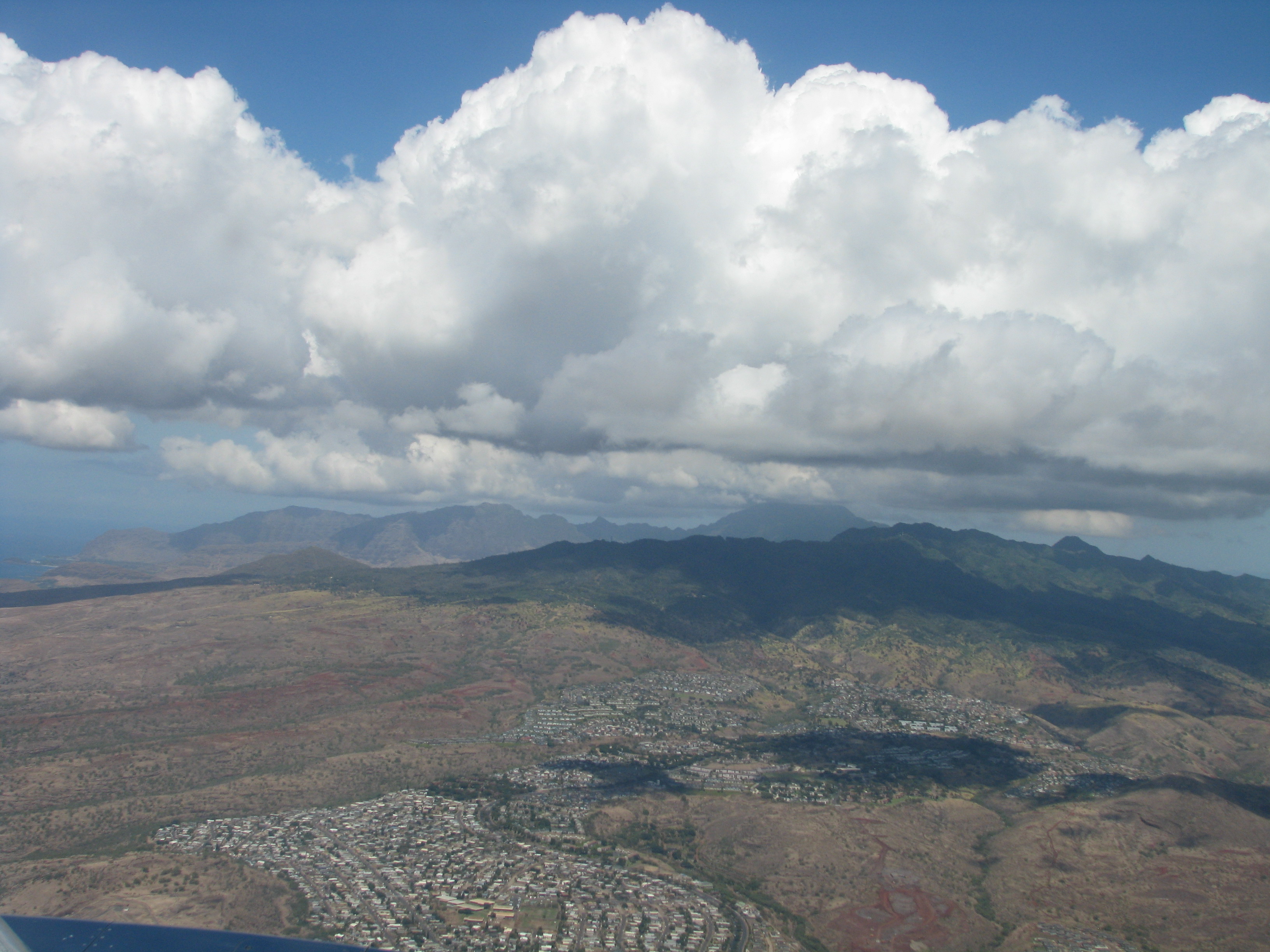-
St. Michael’s Mount

St. Michael's Mount Back to travel photos! While in Cornwall, we had to go to the coastal city of Penzance (because one of our favorite Gilbert and Sullivan plays is, of course, The Pirates of Penzance). From there we walked to the neighboring city of Marazion (don’t do this… drive!) to see St. Michael’s Mount http://www.stmichaelsmount.co.uk/ . From about 350 BC the Mount was a place where much trade took place, especially in local tin. Smuggling, too, I’m sure. Then in 495 AD some fishermen saw on the rocky island the vision of the angel St. Michael. Not long after a chapel was built and religious pilgrams flocked to the Mount.

An imposing structure A priory joined the chapel and the old, glorious castle appeared, jutting out of the hard stone and overlooking everything. Although a place of worship, many times in its history did the Mount have to take arms. Most notably it was from St. Michael’s Mount that the first beacon light was lit to warn of the Spanish Armada.
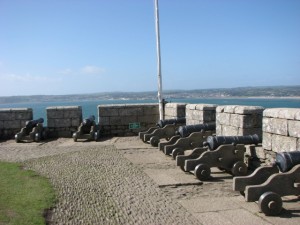
At some times the priory saw battle. After the Dissolution, it was purchased as the home of the St. Aubyn family, which it has remained ever since. In the 1950’s one of the family gave the structure into the hands of the National Trust, with the codicil that the family could live in it for 999 years. What makes St. Michael’s Mount very special is that it can be walked to across a causeway when the tide is low; when the tide covers the cobblestones, it becomes and island. We’d come to know about the causeway as it was used the in movie version of Shakspeare’s Twelfth Night.
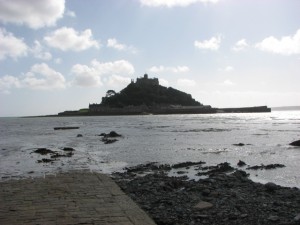
The causeway underwater We walked across the ankle-twisting cobbles to the imposing and ancient fortress.

A ruined gatehouse, with the causeway far below. We were still experiencing the very heavy winds from Hurricane Irene, so at times sand blew into our faces and it was a little hard to stand. Otherwise it was a clear and gorgeous day. Although still a private residence most of the castle can be toured.
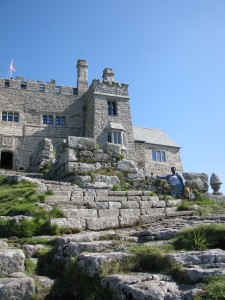
The 'front door' of the castle, facing west. 
Legend has it that a giant once lived on these giant stones. There is a grand library, and the place is rife with window nooks with the most incredible views of the English Channel.
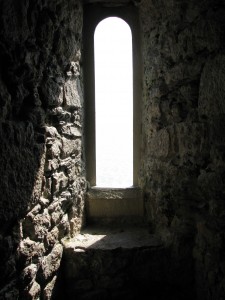
A stony window seat. The amount of labor that went into building these stone fortresses,
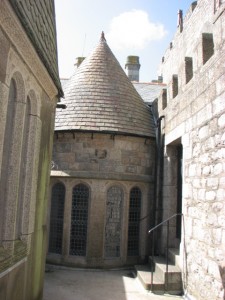
Beautiful and centuries-old workmanship. to make them last for centuries, always amazes me.

At the top of the priory The chapel boasts a rose window dated from the 15th century,

The Rose Window in the chapel as well as other fantastic artworks.
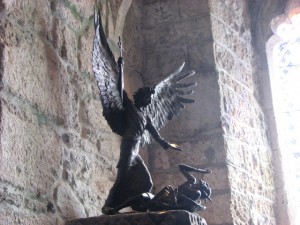
Artwork in the chapel In every room there are displays of beautiful handicraft,

Ornate sugar spoon and some unusual furniture.
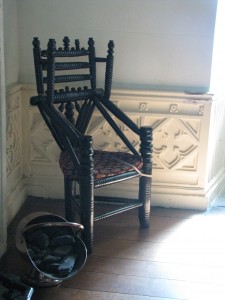
An unusual chair Below the castle are sub-tropical gardens, which were closed the day we were there. We peered down at them and discovered… a good portion of the plants we have here in San Diego!

A view of a window nook, the gardens and the Channel. 
The sub-tropical gardens in temperate Cornwall When we were to leave, the water had just begun to cover the causeway. Some souls were crossing but getting their feet wet as the winds brought the tide in quickly. We waited for a boat ride and for only one pound fifty pence (!) each, we could achieve the mainland!
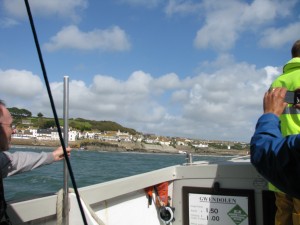
Heading back to shore. The water was choppy but we were with people who joked a lot, which we often found to be true in our British travels, and that made the crossing fun. There are festivals held on the Mount, along with re-enactments and garden tours. Check their website for announcements if you plan to visit, and keep an eye on the tides!
- Animals, Bees, Gardening adventures, Heirloom Plants, Other Insects, Permaculture and Edible Forest Gardening Adventures, Vegetables
What Bugs See
To veer off from the vacation photos, I thought I’d talk about bugs! I’ve been working in the garden a lot and watching the myriad types of insects drawn to the various flowers blooming all over, and it reminded me of something amazing that I learned last year. The way flowers look to us is not what most insects and birds see. The flowers are bright and showy, but they offer up visual clues to pollinators through colors and patterns that can only be seen with eyes that see UV light. Humans can’t. We can’t assign colors to UV light in the way that we understand them, so when photographing with UV light we substitute our colors to show the change in patterns. The markings on the flowers are guides to where the pollen is, like lights and painted lines on airport runways. Just as baby chicks’ mouths are large and brightly colored to show mom and dad where to put the worm, especially on the inside as they gape and wait to be fed, so have flowers made sure that the pollinators get to the right place for pollen! The differences between what we see and what insects see can be startling; there is a whole hidden world right before our eyes, just as there are supersonic and subsonic sounds that we cannot hear. Elephants make subsonic noises that other elephants can hear miles away, but we aren’t aware of it.
Below are photos taken with and without UV light by the brilliant Norwegian scientist-cameraman Bjorn Roslett. Remember that the UV colorization is man-made to show the difference in patterns. More technical information can be found at his site here: http://www.naturfotograf.com/UV_flowers_list.html , with lists of types of flowers and what approximate color changes there are under UV light.
Dandelion Vinca minor Vinca minor under UV Norsk mure (Potentilla norvegica) Norsk mure under UV Primrose Crocus Anemone -
The Lost Gardens of Heligan
If you ever go to England, go to Cornwall and spend at least a day at the Lost Gardens of Heligan (http://www.heligan.com/ ). Due to a flat tire we only spent four hours there and we didn’t see even half of the 400 acres of incredible restored gardens. The story is this: a thousand acres on the southern coast of Cornwall has belonged to the Tremayne family for about 400 years. At the end of the 1800’s, one of the Tremaynes had built extensive theme gardens. There were walled gardens, enormous hedges, glass houses, cold frames, a pineapple pit where the only pineapple grown in Cornwall grew warmed by horse manure. Melon houses, leisure gardens, formal flower gardens, woods, kitchen gardens and unbelievably, tropical gardens, filled the estate. Due to Cornwall’s position by the English Channel the climate is such that with care tropicals can be grown there. The estate was fantastic; then came WW I, and almost half the family and staff were killed. The gardens were abandoned. Subsequent wars and taxes took their toll, and the gardens became overgrown. Vines, brambles, trees and weeds ran rampant, breaking through the glass roofs, pulling apart brick walls, upsetting carefully laid pathways and covering every trace of the gardens under a head-high blanket of tangled, thorny brush.
Twenty-one years ago, the Tremayne who inheirited the gardens, asked one of the founders of the neighboring Eden Project ( http://www.edenproject.com/ ) to try and restore the gardens. The task was phenomenal and reads like a mystery. Hacking through the overgrowth they found the walls, the foundations and the clues as to what had been. Since then the gardens have been restored. They are everyone’s dream of a garden combined. There is a mound that was a beacon mound during Nepolianic times, but then discovered dates back to the Armada, and then back to Medieval times! There is a jungle with massive gunnera plants and palm trees, about half an acre of vegetables all grown from seed that dates from the late Victorian time, walled flower gardens, ‘antique’ poultry and cattle, unique sculptures recently added, and a wildlife garden to encourage the existence of so many insects, birds and animals that are disappearing. Even with weeding through photos I came up with so many that I want to share, that I’ll just post them below. Visit the website and read up on the Lost Gardens, voted Britain’s Finest Gardens. They are magical.
Entrance to a magical world. The Tremayne who built the gardens holding a single Gunnera leaf in front of his famous pineapple pit. Flavors of ice cream… we didn’t get to have any! A mysterious mound was uncovered and thought to have been a beacon site in Nepolianic times, and for centuries beyond that. Stone steps into the ravine The Italian garden Ivy coming through the roof, trying to reclaim the building once again. Hot houses and cold frames Cold frames for veg. Espaliered pears of many varieties. Writing on the wall of the ‘thunder room’, or original composting toilet All plants and veg grown are from the late Victorian period Espaliered fruit trees make use of warm wall space About a quarter acre of mixed greens. Bee skeps (baskets, pre-movable hives) were kept in boles for winter protection. A bee skep in a bee bole History of the Bee Boles A banana grows in Cornwall! Melon houses Potting shed with greenhouses in a walled area. Sigh. Cold frames in the potting shed A robin watches, just like in The Secret Garden The overgrown remains of mud brick walls A very steep pathway lined with chicken wire to prevent slipping The Jungle A wire sculpture of a woman with her arms out… can you see her? A deciduous walkway Mud Woman A very green man -
Jamaica Inn

Our first room was above the pub on the left. I know you are all sick of reading about bathing a hen; I’m back from a vacation in Cornwall, UK and helping my daughter move back to OSU for her Junior year. With a gazillion photos to sort through, I’ll do my best to show you the highlights of our travels as well as keep you up on the growing of my gardens.
Why Cornwall? It is a land of legend, infinite beauty, the birthplace of many famous people, and is home of the pastie (a turnover with savory filling made by wives for lunch for their mining husbands). It was also supposed to be the warmest place in the UK in September, and the best place for birding as all the migrants fly near there. What no forecasting website let me know was that the hurricane that had hit the US East coast had moved north near Ireland, and gale-force winds were hitting most of upper Europe. Cornwall was no exception. The winds hit on the third day of our trip, and let up towards the end, so birding wasn’t so great ( you had to look quickly :). )
Our first lodging in Cornwall was at the Jamaica Inn (http://www.jamaicainn.co.uk/ ). How great is that! For you literary types, or those who love Alfred Hitchcock films, you’ll recognize this Daphane Du Maurier title which had been made into a movie. (Hitchcock also made movies of two of her other works, Rebecca and The Birds).

The Inn had been infamous for smuggling Jamaica Inn sits on the Bodmin Moor in East central Cornwall. When we flew into Newquay (pronounced NEW-key) airport and rented our car it had just begun to rain with a little thunder thrown in for atmosphere. The drive through traffic was slow (the highways have cow crossroads with signal lights!) and as we approached the Inn the fog rolled in.

The museum in the rain. There had been an accident on one of the highways so traffic was backed up. As we gratefully parked in the main parking lot of the Inn, an older man in a yellow traffic vest that had been out on the street came over and suggested that we park in the small lot in the front. He explained about the traffic, and joked about us being ready to meet ghosts at the Inn. I told him that with a meal, dry clothes and a warm bed, let the ghosts do their worst! He laughed and replied that ‘strange things happen around there.’ I moved the car, navigating a forty-five degree turn in a narrow, brick sided gate without scratching the car (England is infamous for this sort of thing), and re-parked. Glancing back at the road, I noticed that the man had disappeared. We never saw him again! Strange things, indeed.
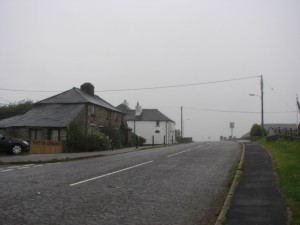
The neighborhood isolated by fog In three nights we stayed in three different rooms because of the Inn being full.

Main entrance We moved from the smallest and oldest room, one which the owner vowed had the most ghostly activity, to a larger, slightly less ghostly room, to finally a large room in the ‘new wing’ with a great view of the Bodmin Moor. The staff knew us as the ‘traveling Americans’. The owner told us that only the night before the guest in that first room had stood up from the bed and felt a hand push him back, twice. We walked through the dark pub, up the winding stairway to our room, named after one of the characters in Du Maurier’s book, and entered our room. It could very well have been the source of many unusual phenomenom. Being in the old section, which dated back 400 years, the floor slanted inward so much that you could imagine yourself shipboard stuck on the roll of a wave. It was great. After a visit to the pub, I don’t doubt that the previous guest had fallen down.

A man who disappeared on his birthday on the moors. The Inn is hundreds of years old, and definately has an atmosphere.

Original stonework and chains At the Rancho Guajome Adobe in Vista, I havethe feeling that the house is like an older woman who was dressed in her finest, hair done up, back straight and proud, welcoming guests to yet another party at her fine home. At the Jamaica Inn, with its slanted floors, swaybacked roof and settled walls, I had the impression of an old, mostly toothless hag, one eye squinty, the other pierceing you with its gaze to see what you’re worth, and cackling at your dismay when you shudder. Wonderful!

Dining in the dark; makes you want a mug with a glass bottom! There was a microclimate that surrounded the Inn; it was always colder, foggier, rainier and windier than even the coastal areas both North and South. We’d awaken to crummy weather and defiantly brave it to visit a garden or ruin, and find the weather a lot better once we left the area! Our last night there was the beginning of the intense gale-force winds. Flag poles were outside our room and they beat a strong tattoo all night. In the morning I pushed the window open against the wind to have a look, and wasn’t surprised at the flag that had beat so furiously in the storm.

The Jolly Roger The moor is not the wild, heath-covered marshy area one would expect anymore. It has been cut into squares for farmland, lined with hedgerows or stacked stone walls. It still is beautiful. The radiant green of British and Irish fields can’t be explained, just loved.

Bodmin Moor through our window. We didn’t have time to hike to the standing stones there, and tried twice to walk to the Dozmary Pool, the legendary home of the Lady of the Lake who kept King Arthur’s sword. We had heard that the ‘bottomless lake’ of legend does, indeed, dry up, and there is another lake that claims the sword as well, so we didn’t feel too badly about missing it. We walked across a field, sinking into wet spots, imagining Jane Eyre collapsed on a moor, and all the other stories and legends surrounding these fascinating places. I was glad to be close to safety!

Yes, that's fog behind the museum The Jamaica Inn does brisk business as a tourist stop, particularly for busloads of ghost-seekers. They visit the Du Maurier museum, the gift store, and have lunch in the dark pub.

On the telephone booth, the only spot of color in the courtyard. There are figures from the book lurking the corners, some of which speak to you when you press a button, and stocks in the front yard.

The harried heroine of Jamaica Inn, and touch of Poe with the cask of Amantillado A ghost log sits next to the guest register for reporting any supernatural activity, and it is quite full.
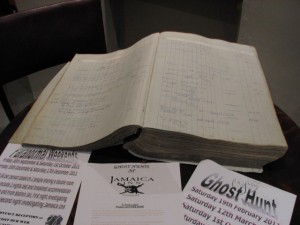
The ghost log I was mildly disappointed in not being spooked; however, if any ghost had tried to wake me up they would have been disappointed, for I was too tired to care!
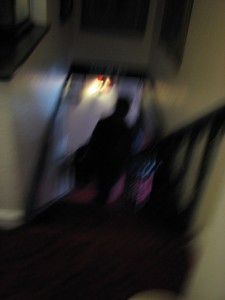
Spooks! Any adventure is enjoyed even more after you are safely home. I loved staying at the Jamaica Inn, soaked up the atmosphere, the grey stones the fog and all the corny spooky stuff set around the Inn. The name Jamaica Inn allegedly came from all the rum that was smuggled through. A plaque on the floor of the bar commemorates a spot where someone had been murdered. I wouldn’t have missed staying there for the world!
-
Bathing a Hen
Between harvesting, drying, weeding, watering and keeping out of the sun, we’ve been very busy with the garden and animals, so I apologize for not writing often. If you’ll remember one of our hens, Evelyn, passed away due to egg binding. Egg binding is just what it sounds like: they don’t come out, and it can be fatal. Another of our chickens, Kakapo, showed signs of trouble and we gave her baths and babied her, and now she is laying enormous eggs (poor girl!). Now Lark, the darker of the two Barred Rocks, is having trouble. She laid one egg and perhaps a weak-shelled one as well, and then nothing. We had her in a cage in the living room, gave her warm baths then put her out. Still nothing. Then yesterday she was acting very strangely during the day, so we gave her another warm bath and a massage.

Lark Spa There isn’t much else to do. Of course, we’re leaving for ten days starting tomorrow, and although there will be a housesitter living here, I don’t think chicken bathing is on her to-do list. Things always happen just before going on vacation, of course, so one of our cats isn’t looking good but refused to be caught, and our desert tortoise Homer is still missing. We have signs up (if people would stop taking them down!) and hopefully he’ll make himself known to people.
I’ll be without Internet on our trip. We will be birding and looking at historical and natural wonders in Cornwall, England, including Land’s End, Penzance, Jamaica Inn, Camelot, and the Isle of Scilly. I wanted to blog on the trip but we are keeping our luggage to carry-ons, and the choice between hiking boots and a laptop was a clear one to me. So I’ll post about our travels after the 16th. Send happy thoughts to our animals and housesitter! Take care. -
The Surprising Facts about Figs
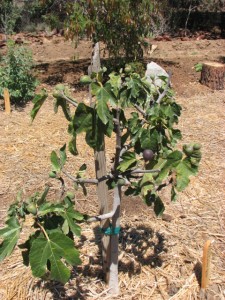
A young common Black Mission fig People either love or hate figs. Figs were grown long before wheat became a crop. They are members of the Ficus family, which includes such spectacular specimens as the famous Banyan tree that grows enormous roots and support trunks from air roots. The fig tree, and members of the ficus family such as the Bodhi tree, are mentioned in all three major religious texts.
However, figs are not fruit. Nope.
Figs are swollen, fleshy stems called syconiums.
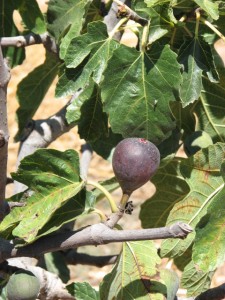
Figs are swollen stems. A fig is actually a swollen, hollow stem that has internal flowers!

The insides of figs show the flowers When the flowers are ready for pollination, the end of the stem opens slightly to allow in the fig wasp, its only pollinator.
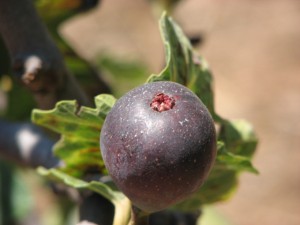
The end opens. The syconium will then set seed inside, which is the time when they are usually harvested. Happily for fig eaters, many fig types are self-pollinating. Now you can amaze your friends and family with this interesting trivia over the dinner table!
-
Top Ten Air Travel Tips (for now, anyway!)
In the last four years I’ve done a little traveling. I’ve flown and drove in England, Scotland and soon Cornwall, and flown to tour Ecuador and the Galapagos Islands. Also I’ve been traveling back and forth to Oregon to see my daughter in college. I’ve learned a few tricks; I’m sure I’ll learn more the hard way each time I travel. Here are ten tips that I find useful and perhaps you may, too:
1. Don’t rely on travel agents to do the right thing.
For my first vacation four years ago, I made a trip to my AAA office. Since I was traveling to England, they couldn’t help me except for booking the plane flights. I looked into all kinds of tours, and finally gave them all up and booked our lodgings, rented a car and off we went under our own sails. We stayed at interesting places and received good rates, too. However, the travel agent booked our return flight to the US and the connecting flight home so closely together that it didn’t take customs into consideration and our flight was gone long before we even collected our baggage (which also goes through customs.) Fortunately it wasn’t one of the major flights. Look online and find the configurations of the airports, and see how far it is to get from one terminal to another, especially if you must switch airlines. Remember that you have to check in at the desk when you change airlines, even if you’ve been ‘checked through’ at the beginning. Otherwise your luggage will be enjoying a tour of your destination while you await another flight. I overheard one woman frantically calling her travel agent because her plane landed in San Diego but her connecting flight was booked from Carlsbad airport, and she didn’t know. After a frantic and expensive taxi ride she found the plane was late, which made everyone miss all connecting flights. She wasn’t happy.
Also when booking online through TripAdvisor, Expedia, Travelocity, or any of the other dot-coms, keep comparing. TripAdvisor compares costs of flights from many different organizations, but try going through the airline’s website. For my upcoming trip to Cornwall, TripAdvisor came up with roundtrip for two at over $5,000. I almost dumped the whole trip. I went outside, visited the chickens, cooled off, then came in and checked United, where I have the Mileage Plus program. The trip came out to roughly $2500. Still a lot of money, but half of what had been proposed. Plus I earn mileage for the trip which I can use when booking flights to and from my daughter’s university. If you want to do it right, do it yourself! The best laid plans can go awry with one late plane or a little fog over San Francisco (I try to avoid changing planes there), so go with the flow.
2. Bring dental floss
When we went on an 8-day boat tour of the Galapagos Islands, something inextricable wedged in my teeth. On a small boat for eight days, I had no way of obtaining floss. My gum swelled and was distracting. I wish I had brought dental floss. Besides its regular use, dental floss is strong enough to be used as string or thread to tie up or on errant clothing, luggage tags, bandages, and much more. Plus it has its own built-in cutting device that isn’t considered a weapon.
3. Leave lots of time to switch terminals.
If you have an International flight, you will probably have to go to a different building entirely than the domestic flights. You’ll probably have to not only walk a great distance with your luggage, but take a tram to the other building. It can take 45 minutes from gate-to-gate if you are a fast walker and the tram isn’t full, and then you must check in at the desk and deal with your luggage again. So when booking your flight, make sure you leave a lot of time between flights.
4. Read reviews of airports.
Often when you book flights online, the information given is a pack of lies. Reading reviews of the airports and flights may give you tips about surprises that would have completely messed up your trip. For instance, a flight into England with a connecting flight to somewhere else in Britain may not even be at the same airport, and the fine print or initials may escape your notice. In fact, for many flights you must travel from Heathrow to Gatwick airports, and reviews say that with traffic it could take a couple of hours to travel, plus going through customs, gate check in, etc. Some flight packages say there are only one or two stops, but actually there is a third hidden one where you must deplane and board another. This happened in Bogotá, Columbia on the way to Ecuador. Machine-gun –bearing, camouflaged soldiers stood guard all throughout the airport since it is such a hotbed for drug smuggling.
5. Pack as little as possible, under 22 lbs.
You really don’t need to bring much: you aren’t moving. Bring a bar of soap for washing yourself and your clothing and invest in some good travel clothing that dries quickly. An excellent way to dry wet clothing is to lay it flat on a towel, roll the towel up, then with a partner or by stepping on one end, wring the towel as hard as you possibly can. The clothes inside will be just barely damp and will have a better chance of drying overnight hung out in the bathroom or over the heater in the room. By packing light clothes and washing often, you can get away with a small rolling suitcase and another small bag or purse or backpack, neither of which need to be checked as luggage. Keep the weight of a bag to 22 pounds or under if you will be traveling on small aircraft because many have weight regulations. Leave a little leeway for souvenirs on the return trip. Besides, waiting for your luggage to magically appear can add half an hour or more to your airport time, and if your luggage is lost, getting it back can be chancy.
6. Switch to solids or powders if possible; use tiny plastic bottles for everything else.
Liquids must be in containers no larger than 3 oz, and all liquid containers must fit neatly in a sandwich bag. I have no problem with security regulations because that is what must be done to try and protect us from the crazies. To make life easier when traveling, use creams, solids or powders when traveling to keep the liquids to a bare minimum, and transfer any liquids into small plastic travel bottles that you label clearly and put tape over.
7. Put all pharmaceuticals into plastic zip-lock bags, liquid or not.
Something will spill. Count on it. A lid will pop off or something will break, and then toothpaste will be all over your jeans, or nail polish all over your medications. I put soap and razor in one plastic baggie (the soap will be wet when I put it back in), medications, bandages, Imodium, travel sickness pills, daily small baggies of vitamins or daily medications, and any other dry stuff, into another plastic bag. Toothbrush and paste and floss go into another. When in the hotel, I put the bag with the soap in the shower, the bag of toothbrushes by the sink, and the other bags on the counter so everyone with me can get at them. It is so easy to pack up and keep anything wet or breakable from contaminating everything around it. I have also been told that putting your passport, license, and money into a plastic zip bag is a wise thing to do, so in case you survive a crash landing in the ocean, getting home will be very easy because all of your important things have been waterproofed. I haven’t done that. I’m taking my chances.
8. Be polite and kind to airline personnel, particularly those at the gate.
What an awful job! As bad as working at the DMV. These people are smiling through gritted teeth while being insulted and harassed and cursed at by people who are suffering through their travels. These scapegoats have loved ones and sore feet and car trouble, just like everyone else. Be nice to them with a smile, especially if they are grumpy looking. They are probably that way because the last guy just made life hell for them.
9. Drink lots of water.
By the time your body tells you it is thirsty, you are already a little dehydrated. Travel dehydrates the body. Drink lots of water, even if you need to squeeze down the aisle and cram yourself into the tiny lavatory because of it. All those germs your body is trying to get rid of will be washed away better, your digestion from the strange food will be eased, and swelling and aches from sitting so long won’t be so severe when you have adequate water in your muscles. Tea, coffee and alcohol dehydrates, so drink pure water.
10. Bring your own food.
It is no longer a given that you will receive a meal on a flight, or even the so joked about packet of peanuts. Many flights offer nothing, or just beverages, or have a selection of horrible foods to purchase. Often boxed lunches include a cold sandwich, a packet of salty pretzels or chips, a packet of cookies, and more condiments than you could ever hope to use. Being vegetarian, it is very difficult to eat adequately on long flights that don’t offer standard meals. However the vegetarian food when we do get it has been pretty good, all-in-all. Since I used to travel with children and with my mother who needed to keep her blood sugar up, I’m used to baking small muffins or sandwiches the day before the trip. I try to make things that will last several days. Even after reaching our destination we’ve resorted to eating our snack foods for several days between meals. For most people who are used to fast food and eat meat, it is easier to buy from one of the stores at the airport and carry it onboard, but I find home cooked food helps keep tummies stable.
Hopefully these tips can help if you aren’t already familiar with them. If you like to travel, don’t put it off. See what you want to see while you can. Time flies, and so should you. -
Strawberry Shortcake

Serve with a dollop of whipped cream. Strawberries are the quintessential food of summer. Whether served plain, dipped in sugar, chocolate or a sweet fondue, mashed and drizzled with balsamic or flavored vinegar, chopped and mixed with vanilla ice cream, strawberries are happily both delicious and nutritious. Between summer’s heat spells, take time to light up the oven and treat yourself to some strawberry shortcakes. They taste as if they were difficult to make, but they aren’t.

Grate frozen butter into the flour. Before you begin, throw 1/2 a cup of unsalted butter into the freezer.
Strawberry ShortcakesAuthor: Diane C. KennedyRecipe type: Dessert or BreakfastPrep time:Cook time:Total time:Serves: 8 - 10These scrumptuous, not-too-sweet cakes are ideal for a summertime dessert or for a special breakfast or brunch. You can even serve them at high tea!Ingredients- 2 cups all-purpose flour, plus more for dusting
- ½ teaspoon salt
- 1 tablespoon baking powder
- ½ teaspoon lemon or orange zest
- 5 tablespoons sugar, divided
- ½ cup unsalted butter, frozen
- 1 large egg, beaten
- ½ cup cream or ½ and ½
- 1 large egg white, lightly beaten
- 10 - 12 ounces fresh ripe strawberries
- 1 tablespoon sugar
- 1 cup whipped cream
Instructions- Heat oven to 425F.
- Stir together the flour, salt, baking powder, zest and 3 tablespoons of the sugar in a bowl.
- Grate the butter into the dry ingredients, then with your fingers or pastry blender gently incorporate the butter into the flour.
- Whist the egg into the cream and slowly pour into the dry mixture while mixing with a fork, just until the dough begins to form (you may not need all the liquid).
- Turn the dough out onto a lightly floured area and roll gently to about ¾ ".
- Dip the cutter in the excess flour and cut out rounds.
- Place the shortcakes one inch apart on a greased baking sheet, or one lined with parchment paper.
- Gather the scraps of dough and continue rolling and cutting until used up.
- Brush the tops of the shortcakes with egg white and sprinkle with one teaspoon of remaining sugar.
- Bake for 10 - 15 minutes until golden brown.
- Allow to cool on a wire rack (you'll want to eat them while warm).
- Slightly crush the strawberries to release the juices.
- Sprinkle with last teaspoon of sugar. You may also drizzle with balsamic or flavored vinegar, stir in fresh snipped mint leaves, or stir with a tablespoon of whiskey.
- Split each shortcake lengthwise and add strawberries and a dollop of whipped cream, then top with the other half of the shortcake like a little hat.
- Makes 8-10 shortcakes.

Gently cut into 2 1/2 inch rounds. 
Bake until browned, then cool on a rack. -
Of Monarchs and Milkweeds

Monarch (photo: Miranda Kennedy) The migration of the monarch butterfly covers an astounding 2500 miles. Instead of dying off in the cold of winter, these flimsy, light-as-air insects fly from parts of the US to groves of Oyamel fir trees in Mexico. They are the only insect to cover such territory. They are particular little beasties, for they rest only in the Oyamel firs and look for milkweed plants on which to lay their eggs. Milkweed exudes a sap toxic to animals which the Monarch caterpillars eat, obviously immune, making them toxic in turn. The caterpiller’s bright coloration is a warning.

Snazzy stripes mean 'eat at your own risk' (photo: M. Kennedy In fact, the Viceroy butterfly, which is very tasty to predators, mimics the Monarch’s coloration to keep from being dinner.
Deforestation, insects, climate change and pollution have cut a huge swath through the Oyamel fir tree population, and the Monarchs are struggling to survive. They also combat the decrease in milkweed as human populations spread and plant lawns instead of weeds and wildflowers.
At the beginning of this year, in my efforts to change my property into habitat, I was determined to help the Monarchs. Every year I see maybe one or two of the majestic butterfly pass through my yard, and I’ve been sorry that I can’t offer he or she anything except nectar.
What I had been calling milkweed actually is sow thistle Sonchus oleraceus, which is an edible kitchen herb brought over from Europe with the settlers as food. It also has a milky sap in it’s hollow stem, thus the erroneous name of milkweed. There are over 100 varieties of real milkweed. So, I purchased two Balloon Plants, or Asclepias physocarpa (Asclepias is the botanical name for the milkweed family). They grew quite well, developing the balloon-shaped seed pods which, when ripe, burst open spreading small seeds with feathery wings attached that carry them everywhere.

Seeds burst and fly To my great excitement my daughter spotted very tiny Monarch caterpillars on the leaves!

Tiny Monarch caterpillers (photo: M. Kennedy) The caterpillars have been eating voraciously and growing big and fat.

Monarch caterpiller and milkweed (Photo: M. Kennedy) We’ve seen Monarchs in the yard many more times than in the past. We are monitoring the caterpillars closely, waiting for them to metamorphosize. I’ll help the plants distribute seeds throughout my yard, and I’ll plant the native narrow-leafed milkweed as well. I’m so excited that within months this goal was achieved and that these wonderful creatures have one more place to find refuge.
Good links:Monarch Watch http://shop.monarchwatch.org/ , Monarch Migration http://www.monarchbutterflyusa.com/Migration.htm.
-
King Watermelon
This year I grew watermelons. I planted organic seed in my raised vegetable bed, protected from gophers by aviary wire, grown in excellent soil and fertilized with organic fertilizer, watered often, and the vines produced three melons the size of grapefruit. The chickens enjoyed them very much. However, a non-organic watermelon from a six-pack stuck in the ground under a bamboo, decided to take over the world. Not only did it’s foliage cover a good portion of the upper soil, but it grew and has grown enormous beasts of watermelons. One we call King Watermelon.

King Watermelon is in the foreground, laying in wait. My daughter and I watched a YouTube video on how to tell if a melon is ripe. One way is to watch the tendril opposite the stem of the watermelon, and when it turns brown the melon should be ripe. The area where the stem connects to the fruit should also turn a little brown. Also, under the melon should be a pale spot where it rests on the ground, and when that area turns from white to yellowish, that is another sign. King Watermelon had no spot. We checked every few days for weeks as the beast grew larger and larger, it’d tendril tenaciously green. Then suddenly, it was brown. Much celebration. My petite collegiate daughter crept up on King Watermelon and swiftly cut it’s stem. Then staggering with it, brought it into the house where we weighed it. It was an incredible 28 pounds. It is a wonder that any other plant in the area got any irrigation! Normally we’d slice the melon on the countertop, but King Watermelon was so large that he had to go into the kitchen sink, and he barely fit! It was there that he was butchered, in consideration of all the juice that might come out.

So large it had to be 'butchered' in the kitchen sink! The insides were perfectly sweet, juicy and crunchy. I couldn’t believe how perfect it was.

Beautiful inside; sweet and crisp. My daughter cut and cut, saving some for our dinner (all that extra water before bedtime wasn’t a great idea, though), and wrapping the rest. The chunks had to be stored on cookie sheets to distribute the weight on the shelves and protect from leaking juice. We had watermelon the next day too, and fed some to our very grateful and thirsty tortoise during the heat wave. There is a lot of King Watermelon left. It is scary to look into the refrigerator and see it all. Even cut up and wrapped, that melon still has an attitude. And I think he won the battle after all.

Wrapped sections for infinite eating. And there are more melons ripening with each passing minute. Gulp.






